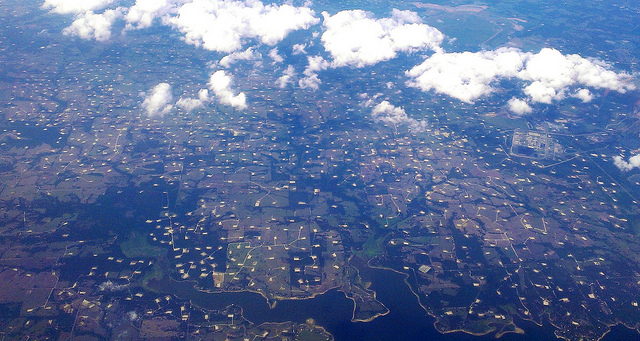by Mathew Bukhi Mabele (Department of Geography, University of Zurich) and Jacob Weger (Department of Anthropology, University of Georgia)
It has been sixteen years since Paul Crutzen and Eugene Stoermer first introduced the term ‘Anthropocene’ to signify that the ‘growing impacts of human activities on earth and atmosphere’ had reached planetary proportions. Their central argument is that we are now living in an era where humankind has become the dominant force behind global environmental change, altering the functioning of the entire Earth System.
The term implies the arrival of nothing less than a new epoch in Earth’s natural history, one defined by the activities of humanity writ large. Human activities on Earth – such as deforestation, increased greenhouse gas emissions, agriculture, urbanization, etc, – have altered geological processes, such as erosion and sediment transport, and changed the chemical composition of the atmosphere, oceans and soils to a degree rivalling that of the glaciers during the Ice Age, leaving an indelible mark on the Earth’s strata.
The concept continues to attract both scholarly and mainstream attention, spawning endless debates over its accuracy and implications for economic activity, social justice and environmental futures. Indeed, the topic has been hotly contested by natural and social scientists alike, albeit for largely different reasons. But what does the concept of the Anthropocene imply for devising and implementing pathways to sustainability? What can the idea of ‘dynamic sustainabilities’ contribute to the Anthropocene debates? These questions were the starting point for a discussion panel we organized at the Dimensions of Political Ecology conference at the University of Kentucky, February 26-27, 2016.

Crutzen, Stoermer and other earth scientists’ early discussions of the Anthropocene concept have been critiqued by social scientists like Holly Buck for producing anxiety-driven, gloomy, anti-historical, non-contextual narratives of human-induced environmental change. According to geographer Paul Robbins, ‘[t]o announce the Anthropocene is to suggest that it was as if humanity was a single planetary force, comparable to plate tectonics, the rock cycle, and other earth-scale systems’. Highlighting the significance of this critique, Christian Kull argues that the concept collapses all human difference, ignoring the fact that some are more responsible for such large-scale changes than others. The Anthropocene concept also focuses our frame of analysis and response on the global scale, creating what anthropologist Arturo Escobar calls a ‘globalocentric’ perspective on resource management.
These Anthropocene narratives stoke a ‘discourse of fear, not hope,’ and reinforce ideas about the need for increasingly hierarchical technical planning and control of nature, making the Anthropocene more a tale of domination than emancipation. Some question the scientific culture arising around the Anthropocene that displays a panicked political imperative, described as ‘Ecological Anxiety Disorder’, to intervene more vocally and aggressively in an earth transformation run amok. This discourse limits appropriate responses to environmental change, channeling them into narrow options of recovery, restraint, and control.
Regardless of where one stands on the Anthropocene concept, it is clear that it has gained major traction in wider debates about the relationship between humans and the environment and the scale of contemporary environmental change.
These fall into three broad categories:
- debates around the precise starting dates for the Anthropocene
- discussions of the political and ethical implications of the term ‘Anthropocene’ and potential alternatives to it and
- epistemological differences between natural and social sciences and calls for greater interdisciplinarity in addressing Anthropocene challenges.
We think that there is limited discussion in these debates around the need for a plurality of perspectives, or of the inherently political nature of a quest for sustainability that would embrace both environmental integrity and social justice. Informed by the ‘pathways approach’ as developed by the STEPS Centre, which brings critical attention to the framing and narratives of social and environmental change, and considers complexity, power and politics, including the politics of knowledge, in shaping development and sustainability outcomes, we decided to bring these ‘dynamic sustainabilities’ together with the Anthropocene concept.
The conference panel (and the series of blogs that will follow) begins where conversations during the STEPS Centre Summer School 2015 left off, and the researchers that responded to our call for papers are an impressive and diverse bunch, making for a really dynamic series of conversations.
Petter Törnberg asks how complexity science can offer lessons for “wicked problems” such as sustainability. Ehsan Nabavi (a STEPS Centre Summer School alumnus) analyses the role of urgency and technocratic knowledge politics in narratives of environmental crisis with examples from Iran’s water management sector while Julia Duchesne seeks alternative understandings of justice in the Anthropocene through traditional ecological knowledge and local power dynamics in Canada’s Yukon Territory. Lastly, Thomas Håkansson brings land, labour, and value to challenge some basic assumptions of the Anthropocene conceptualization of anthropogenic change with a discussion of ‘landesque capital’.
We hope you will enjoy reading them. Please join in on the conversation by leaving a comment.